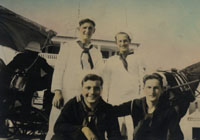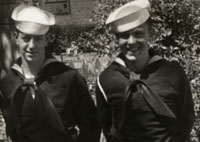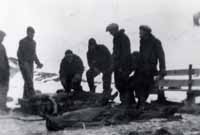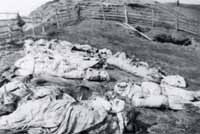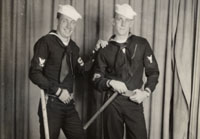Chapter 5: The Story – Dead Reckoning
Rescue, Part II – The Truxtun
On board the Truxtun, meanwhile, about 100 men were still stranded. Many did not want to try swimming to shore – they had watched their friends and shipmates drown or get tossed against the rocks and could even see some of the bodies bobbing up and down in the water around them. Yet their ship was breaking up beneath them and filing with seawater. Great waves repeatedly lifted the vessel and dropped it on the rocky ocean bed. The rear portion of the ship had broken off completely and cracks were snaking through other parts of the vessel.
The Newfoundlanders on the beach focused their efforts on getting these sailors to shore. Three men – Theo Etchegary, Sylvester Edwards, and Mike Turpin – tried to free the two rafts tangled up in the lifeline. They waded into the water until the waves reached their shoulders, but with no luck – the rafts and ropes were firmly snagged on the ocean floor. At about the same time, the SS Kyle – a coastal boat that delivered mail and other goods to local communities – steamed near the entrance of the cove. The vessel's captain, Tom Connors, heard of the shipwreck while docked at St. Lawrence and hoped he could effect a rescue from sea. But it was impossible. The stormy waters were far too rough for even a crew accustomed to navigating these coastal areas to venture into.
The only option was to abandon ship – and the sooner the better. The Truxtun was almost lying on its side by now and water was pouring in. Powerful waves rolled over the sinking destroyer and often took a few sailors with them; some survived, but many died. Soon the ship's mast snapped off. Then its forward section broke away, leaving the Truxtun in three pieces in the middle of Chambers Cove. The Newfoundlanders urgently signalled to the men to swim to shore, but only a few jumped into the water. When they did, the men on shore formed themselves into a human chain that extended from the beach to as far into the water as the men could go. When a swimmer came within reach, they pulled him to safety. None of the rescuers seemed to notice that they were by now as wet and oil-soaked as the people they were saving.
Suddenly a giant wave engulfed the Truxtun and took with it about 30 sailors, almost all of whom died against the rocks. This was followed by a second great wave, which pulled another 20 or so men into the water. A few made it to shore, but most drowned or were dashed against the rocks. Waves also washed away part of the ship's bridge and any men still inside.
Some of the rescuers on shore spotted a lone sailor clinging to a small piece of rock that was surrounded by pounding waves. Trapped and terrified, he was calling out for help. But there was no apparent way to reach him – the water was dangerously rough and he was below the tallest part of the cliff. Rescue by land or water would be impossible. Then, St. Lawrence resident Henry Lambert came up with a plan: he tied a rope around his waist and asked his fellow rescuers to lower him down over the cliff to the stranded sailor. If the rope broke, or if the men above lost their grip, then Lambert would certainly die. But the 25 year old was as fearless as he was courageous – with a dozen men holding onto the rope, Lambert was lowered onto the oil-covered rock. He grabbed the petrified sailor and the two men were pulled up to safety.
Back on the beach there was a sudden commotion – a dory had appeared at the top of the cliff! It belonged to St. Lawrence resident Adam Mullins, who had pulled it to the wreckage site on a horse-drawn sled. Perhaps he could launch it in the water and rescue the last few terrified men clinging to the side of the Truxtun. By now only three men could be seen. Wasting no time, the dory was lowered over the side of the cliff with a rope. Mullins and two other Newfoundlanders – Charlie Pike and Dave Edwards – climbed inside and began to row towards the destroyer. On the beach, some men held onto a long rope that was attached to the dory – if there was trouble, they would try to reel in the boat and its passengers.
Over the oil and through the waves the dory went. As the men rowed through rolling seas, they saw the floating corpses of drowned sailors – an image that would stay with them for years. They were a few seconds away from reaching the Truxtun when a tremendous wave poured over them. Pike was tossed out of the dory, one of the three sailors onboard the Truxtun was washed away, and a second, Edward McInerney, was thrown into the dory. In the chaos, Pike managed to grab onto the side of the dory as the men on the shore began to pull it in.
Donald Fitzgerald was the last man holding onto the Truxtun. He knew that if he wanted to survive, he would have to do something fast. Launching himself from the side of the wreckage, he managed to grab the rope attached to the dory. But then a strong wave took hold of him and tore the rope from his grasp. Fitzgerald was helpless – he would have to go wherever the water took him. Fortunately, it threw him onto the beach. The last two survivors of the Truxtun reached shore at about 3:00 in the afternoon – almost 11 hours after the vessel had gone aground.
A little earlier, a man from St. Lawrence named Lionel Saint was surveying the wreck site from the top of the cliff when he noticed some debris and oil drifting in from the west. It had not come from the Truxtun, but it looked similar to the flotsam surrounding that ship. Could there be another vessel aground further along the coast? Saint decided to find out and began walking toward Lawn Head.
From Ship to Shore – The Pollux
By 9:00 in the morning, the crew of the Pollux had made several attempts to reach shore, but with no luck. Worse, all but one of their rafts and lifeboats were by now damaged beyond use. Only the small wooden whaleboat remained. Fortunately, it was powered by a small engine that was still working. Could this small boat make it through the violent seas to shore? Five men volunteered to find out – Jack Garnaus, Garrett Lloyd, Warren Greenfield, William DeRosa, and Lawrence Calemmo. They entered the whaleboat and tied a rope to Garnaus's lifejacket, which would allow them to establish a line from ship to shore if they reached the cove. Then their crewmates lowered the small open boat into the turbulent waters below.
Calemmo started the engine before the boat hit the water and kept it racing to prevent it from stalling. “Away we went,” he later said of that desperate boat ride. “First forward like crazy and then back like crazy while the waves were breaking over us. I would race the engine to fight the pull and the push of the surf and by now the boat was quite flooded. Lloyd was struggling to keep the bow aiming for the spot we had picked out.” (Tape 38 12:55-13:07)
Suddenly a large wave picked up the boat and smashed it against some icy rocks in the cove. The five men were tossed into the water and became separated into two groups – Garnaus, Greenfield, and DeRosa fell over the port side of the whaleboat, while Calemmo and Lloyd went over the starboard side. “Lloyd and myself was in the surf up to our waists and we both fought like hell to get out,” Calemmo later said. “We finally climbed onto the ice-covered rocks and crawled on our stomachs up and away from the surf until we finally came to this cleft with the ground being somewhat level for about an area of about six feet by ten feet. Being exhausted and wet with oil as well as water, there is where we stayed. As a matter of fact, later we tried to work our way out and found that we had to stay because we were trapped. I then realized I was missing my right shoe and I was bleeding from my hand slightly. Lloyd seemed ok.” (Tape 38, 13:45-14:30) Trapped in the cave, Lloyd and Calemmo could do little more than huddle together for warmth and hope that help would arrive soon.
The other three men had been tossed out the opposite side of the boat into waist-deep and freezing-cold water. They managed to wade to shore and scramble over some rocks onto a small plateau, where everything was by now covered in either ice or oil. It was bitterly cold – the wind and sleet stung their exposed hands and faces, and sapped what little energy remained in their worn-out bodies. Nonetheless, the men began to pull in the lifeline connected to the Pollux.
However, they had only taken a light-weight line to shore, which would not be strong enough to support a breeches buoy. The sailors still onboard the supply ship attached a heavier line to the light one and signalled to the men onshore to begin hauling that in. Unfortunately, it quickly became coated with ice and weighted down with oil, making the line almost impossible for the exhausted men to pull in. All feeling had gone from their naked hands by now and they were shivering uncontrollably. It was simply impossible for them to pull in the heavy line no matter how desperately they tried. They tied the light line around a boulder and decided to climb to the top of the cliff – with any luck they would find some houses or farmland up there, or at the very least a sheltered area to rest in for a while and recover some strength.
But only bitter disappointment greeted them at the top – no houses, no trails, and no form of shelter. Just a vast and desolate snowy expanse. After a bit of scouting, Garnaus found a shallow ravine where a small clump of stunted trees could offer a small degree of shelter. By now, DeRosa was in very bad condition. Shivering and barely conscious, he had to be carried to the ravine by the other two men. Greenfield stayed close to DeRosa, trying to rub life back into his frozen body, while Garnaus explored the surrounding area.

